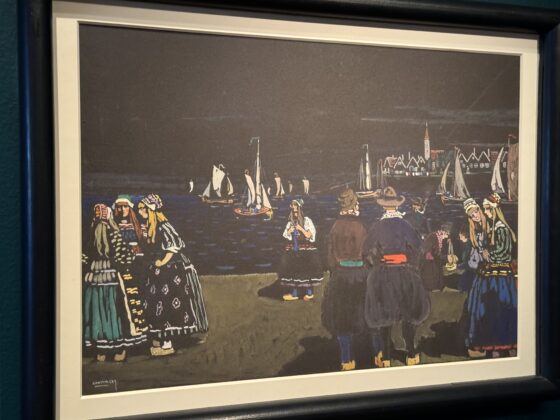The point is political: Kandinsky exhibition at H’ART museum
Senay Boztas
What is a point? Or the temperature of a vertical line? Or the feeling of a colour? A Kandinsky exhibition in the new H’ART museum explains what the celebrated Russian 20th century artist was about and why people pay millions for his works.
Thanks to an extensive loan from the Centre George Pompidou in Paris and the input of two contemporary artists of sound and word, the museum on the Amstel charts, illuminates and animates the work of this master of abstraction.
“This exhibition is about one of the greatest artists of all time and reveals the personal journey of an artist,” said Annabelle Birnie, director of H’ART museum at a press opening. “We want to inspire audiences to look at art from a different perspective.”
With this aim in mind, the museum has borrowed around 65 works from its new, official partner, the Centre George Pompidou. It has also commissioned a series of videos from artist Bink van Vollenhoven, with an actor bringing to life Kandinsky’s voice, personal motivations and ideas, and a spacey, electronic music “soundwalk” to accompany the works, created by DJ Søren Siebel.
“What we both were trying to do was connect Kandinsky’s work with now, with current topics and discourses,” said Siebel. “We were asking how his work would resonate in our times.”
Drawing on his writings, van Vollenhoven created six scripts to explain key points in Kandinsky’s career as well as a series of videos for children, animating his abstract paintings and ideas. Their works are integrated into a chronological exhibition of some of Kandinsky’s greatest paintings, some of which rarely travel.

Art over borders
Wassily Kandinsky, was born in Moscow in 1866, decided at the age of 30 to leave behind a legal career and become an artist. He was also, as one of the videos explains, a serial migrant, fleeing war and political upheaval in search of a more positive future. “I am both a refugee and a tourist…travelling to find like minds,” he says in Van Vollenhoven’s video.
He first developed his art in Munich, founding the Phalanx creative association, but when World War I began, fled to Moscow. Invited to teach at the Bauhaus art school in Germany in 1921, he again fled Germany for Paris with the rise of the Nazis in 1933. Kandinsky died at his French home in Neuilly-sur-Seine in 1944, just before World War II ended. His widow, Nina Kandinsky, bequeathed a huge collection of his works, sketches, writings and objects to the Parisian museum, which will soon close for renovations.
The exhibition also includes a series of rare, impressionistic paintings he made on a trip to the Netherlands in 1904. It tracks his chronological journey towards increasing abstraction, developing his idea of “autonomous art”, which aims to use colour and form to create an emotional experience for the viewer. It also recreates a life-sized painting of the walls of an entire room, Salon, which he made for the Bauhaus with his students in 1922.
“Visitors are invited to follow the extraordinary history of Kandinsky, who first realised art without references to the physical world,” said Angela Lampe, senior curator of modern art at the Centre Pompidou. “From Russia to France via Germany, Kandinsky defended the universal dimension of art like few others. [He said himself] ‘the work as a whole, that which is called art, knows neither people nor borders but only humanity.’ A wonderful message in these dark times.”

Power
H’ART Museum was formerly Hermitage Amsterdam but broke its ties with its former Russian museum partner due to the war in Ukraine and renamed itself. It will now collaborate with long-term partners including the French contemporary museum, the British Museum in London and the Smithsonian American Art Museum in Washington.
King Willem-Alexander officially opened H’ART museum on Tuesday and the Kandinsky show opens to the public from June 19 to November 10. There are 12 live sound events, “creating an immersive space in which the art works can be experienced”.
The aim is to tell stories with continuing relevance and Siebel said the contemporary element tries to connect Kandinsky’s work with modern meaning and political messaging. “That’s the great power of abstract art that a dot, a line, a gradient can tell us something about questions that we all have as societies, as people,” he said. “It tells you that what you know is not all.”
Thank you for donating to DutchNews.nl.
We could not provide the Dutch News service, and keep it free of charge, without the generous support of our readers. Your donations allow us to report on issues you tell us matter, and provide you with a summary of the most important Dutch news each day.
Make a donation